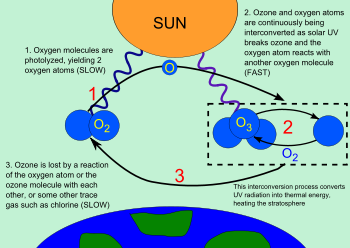
Thirty years ago, the Montreal Protocol was agreed to phase-out the production of substances destroying the ozone layer.
But new research published today in Atmospheric Chemistry and Physics, a journal of the European Geosciences Union, reveals an unexpected growing danger to the ozone layer from chemicals not regulated by the treaty.
It is thought that the new threats come from chemicals used for paint stripping, agriculture, and the production of pharmaceuticals and PVC, which are predominantly being emitted from China.
Lead researcher Dr David Oram, from UEA’s school of Environmental Sciences, said: “Ozone depletion is a well-known phenomenon and, thanks to the success of the Montreal Protocol, is widely perceived as a problem solved.
“The treaty has helped the layer begin the slow process of healing, lessening the impact to human health from increased exposure to damaging solar radiation.
“But our research shows that increasing emissions of ozone-destroying substances are threatening the recovery of the ozone layer.”
The substances in question were not considered damaging before as they were “generally thought to be too short-lived to reach the stratosphere in large quantities,” said Dr Oram, a research fellow of the UK’s National Centre for Atmospheric Science.
The new study raises the alarm over fast-increasing emissions of some of these very short-lived chemicals in East Asia, and shows how they can be carried up into the stratosphere and deplete the ozone layer.
Emissions of ozone-depleting chemicals in places like China are especially damaging because of cold-air surges in East Asia that can quickly carry industrial pollution into the tropics.
It is here that air is most likely to be uplifted into the stratosphere. This means the chemicals can reach the ozone layer before they are degraded and while they can still cause damage.
One of the new threats is dichloromethane - a substance with uses varying from paint stripping to agricultural fumigation and the production of pharmaceuticals. The amount of this substance in the atmosphere decreased in the 1990s and early 2000s, but over the past decade dichloromethane has become around 60 per cent more abundant.
Dr Oram said: “This was a major surprise to the scientific community and we were keen to discover the cause of this sudden increase.
“We expected that the new emissions could be coming from the developing world, where industrialisation has been increasing rapidly.
“Our estimates suggest that China may be responsible for around 50-60 per cent of current global emissions [of dichloromethane], with other Asian countries, including India, likely to be significant emitters as well.”
The team set out to measure air pollution in East Asia to find out where the increase in dichloromethane was coming from and if it could affect the ozone layer.
The scientists collected air samples on the ground in Malaysia and Taiwan, in the region of the South China Sea, between 2012 and 2014, and shipped them back to the UK for analysis. They routinely monitor around 50 ozone-depleting chemicals in the atmosphere, some of which are now in decline as a direct consequence of the Montreal Protocol.
Dichloromethane was found in large amounts, and so was dichloroethane, an ozone-depleting substance used to make PVC. China is the largest producer of PVC, which is used in many construction materials, and its production in the country has increased rapidly in the past couple of decades.
But the rise in dichloroethane emissions was unexpected and surprising because the chemical is both a “valuable commodity” and “highly toxic”, said Dr Oram. “One would expect that care would be taken not to release dichloroethane into the atmosphere.”
Data collected from a passenger aircraft that flew over Southeast Asia between December 2012 and January 2014 showed that the substances weren’t only present at ground level.
Dr Oram said: “We found that elevated concentrations of these same chemicals were present at altitudes of 12 km over tropical regions, many thousands of kilometres away from their likely source, and in a region where air is known to be transferred into the stratosphere.”
If the chemicals that were now discovered in unexpectedly large amounts can reach the ozone layer in significant quantities, they can cause damage.
“We are highlighting a gap in the Montreal Protocol that may need to be addressed in the future, particularly if atmospheric concentrations continue to rise,” he added.
‘A growing threat to the ozone layer from short-lived anthropogenic chlorocarbons’ is published in the EGU open access journal Atmospheric Chemistry and Physics on October 12, 2017.
Image: Wikimedia Commons
Support Our Journalism
We cannot do without you.. your contribution supports unbiased journalism
IBNS is not driven by any ism- not wokeism, not racism, not skewed secularism, not hyper right-wing or left liberal ideals, nor by any hardline religious beliefs or hyper nationalism. We want to serve you good old objective news, as they are. We do not judge or preach. We let people decide for themselves. We only try to present factual and well-sourced news.







